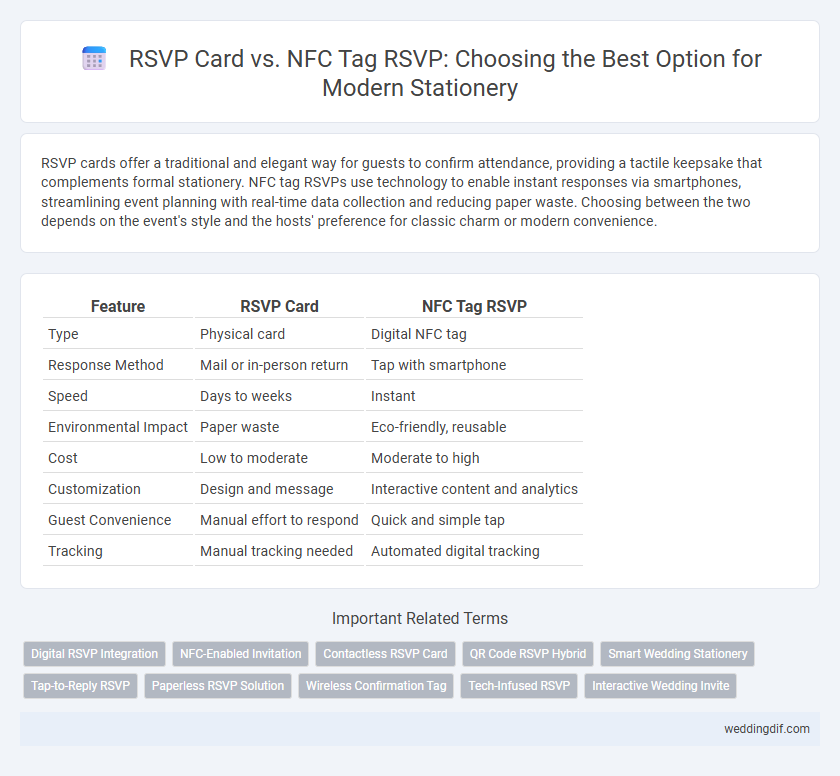RSVP cards offer a traditional and elegant way for guests to confirm attendance, providing a tactile keepsake that complements formal stationery. NFC tag RSVPs use technology to enable instant responses via smartphones, streamlining event planning with real-time data collection and reducing paper waste. Choosing between the two depends on the event's style and the hosts' preference for classic charm or modern convenience.
Table of Comparison
| Feature | RSVP Card | NFC Tag RSVP |
|---|---|---|
| Type | Physical card | Digital NFC tag |
| Response Method | Mail or in-person return | Tap with smartphone |
| Speed | Days to weeks | Instant |
| Environmental Impact | Paper waste | Eco-friendly, reusable |
| Cost | Low to moderate | Moderate to high |
| Customization | Design and message | Interactive content and analytics |
| Guest Convenience | Manual effort to respond | Quick and simple tap |
| Tracking | Manual tracking needed | Automated digital tracking |
Understanding Traditional RSVP Cards
Traditional RSVP cards remain a staple in stationery for weddings and events, offering a tactile and personal way for guests to respond. These cards typically include pre-printed prompts for meal choices and attendance confirmation, enhancing ease of reply. Despite the rise of digital options, many hosts prefer traditional RSVP cards for their classic appeal and tangible keepsake value.
Introduction to NFC Tag RSVP Technology
NFC Tag RSVP technology revolutionizes traditional stationery by enabling guests to confirm attendance through a simple tap of their smartphones, eliminating the need for paper RSVP cards. Embedded with near-field communication chips, NFC tags provide seamless, instant data transfer to event organizers, enhancing accuracy and convenience. This digital RSVP method supports eco-friendly practices by reducing paper waste while enabling real-time event tracking and management.
Comparing RSVP Card and NFC Tag RSVP Features
RSVP cards provide a traditional, tactile experience with customizable designs and handwritten responses, making them a personalized keepsake for events. NFC tag RSVPs offer a high-tech approach, enabling instant digital responses via smartphones, reducing paper waste and simplifying guest tracking through automated data collection. Comparing features, RSVP cards excel in aesthetic appeal and personal touch, while NFC tags prioritize convenience, real-time updates, and eco-friendliness.
Ease of Use: Paper vs Digital Invitations
Traditional RSVP cards offer a familiar, tactile experience that requires guests to manually fill out and mail their response, which can be time-consuming and prone to errors. NFC Tag RSVP technology streamlines the response process by enabling guests to instantly reply using their smartphones, reducing response time and improving accuracy. Digital invitations paired with NFC tags provide a seamless, eco-friendly alternative that enhances user convenience and engagement in event planning.
Accessibility for Guests: Serving All Age Groups
RSVP cards provide a tactile, familiar option accessible to guests of all ages, particularly accommodating older adults who may prefer handwritten responses. NFC tag RSVO enables quick digital replies using smartphones, enhancing convenience for tech-savvy and younger guests. Combining traditional RSVP cards with NFC tags ensures inclusivity, catering to diverse accessibility needs across age groups.
Personalization Options for Both RSVP Methods
RSVP cards offer traditional personalization through printed names, fonts, and color schemes, allowing detailed customization for formal events. NFC tag RSVPs provide dynamic personalization via embedded digital content, enabling guests to interact with unique URLs or multimedia messages tailored to their invitation. Both methods enhance guest engagement, but NFC tags allow real-time updates and customization beyond physical design constraints.
Cost Analysis: Traditional vs NFC RSVP Solutions
Traditional RSVP cards typically incur costs for printing, paper, and postage, with average expenses ranging from $0.50 to $2 per card depending on quality and quantity. NFC tag RSVP solutions involve initial higher costs, approximately $3 to $5 per tag, but reduce long-term expenses by eliminating postage and enabling instant digital responses. Cost efficiency favors NFC RSVP systems for large-scale events due to their reusable nature and streamlined guest management, despite the upfront investment.
Environmental Impact of RSVP Cards vs NFC Tags
RSVP cards, typically made from paper, contribute to deforestation and generate waste when discarded, impacting landfill volumes and resource consumption. NFC tag RSVPs minimize environmental footprint by reducing paper use and allowing digital responses, significantly lowering carbon emissions associated with printing and transportation. Choosing NFC tags promotes sustainable event planning through resource efficiency and waste reduction.
Security and Privacy in Digital and Paper RSVPs
Paper RSVP cards offer tangible privacy with limited digital exposure, reducing risks of hacking or data breaches, but can be lost or intercepted physically. NFC tag RSVPs enhance convenience by enabling secure, encrypted digital responses, often protected by authentication protocols that safeguard guest information. Choosing between them depends on balancing the tactile security of traditional stationery against the advanced privacy controls of digital NFC technology.
Making the Right Choice for Your Wedding Stationery
Choosing between an RSVP card and an NFC tag RSVP for wedding stationery depends on guest convenience and technological accessibility. RSVP cards offer a traditional, tangible option that many guests appreciate for its simplicity and personal touch, while NFC tag RSVPs provide a modern, contactless solution that streamlines responses through smartphones. Evaluating your guest list's tech-savviness and your wedding theme will help determine the best fit for a seamless RSVP process.
RSVP Card vs NFC Tag RSVP for stationery. Infographic

 weddingdif.com
weddingdif.com